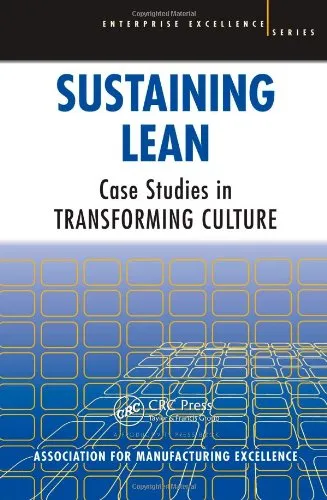Lean Six Sigma Statistics: Calculating Process Efficiencies in Transactional Project (Six Sigman Operational Methods)
3.8
بر اساس نظر کاربران

شما میتونید سوالاتتون در باره کتاب رو از هوش مصنوعیش بعد از ورود بپرسید
هر دانلود یا پرسش از هوش مصنوعی 2 امتیاز لازم دارد، برای بدست آوردن امتیاز رایگان، به صفحه ی راهنمای امتیازات سر بزنید و یک سری کار ارزشمند انجام بدینکتاب های مرتبط:
مقدمهای بر کتاب 'Lean Six Sigma Statistics: Calculating Process Efficiencies in Transactional Project'
کتاب Lean Six Sigma Statistics: Calculating Process Efficiencies in Transactional Project یکی از منابع ارزشمند برای درک عمیق آمار و ابزارهای مرتبط با روش Lean Six Sigma است که به طور خاص در پروژههای تراکنشی و خدماتی کاربرد دارد. این کتاب نه تنها به اصول اولیه Lean و Six Sigma میپردازد، بلکه دیدگاه جامعی از محاسبه کارایی فرآیندها در حوزههای غیر تولیدی فراهم میکند. نویسنده با ارائه توضیحات شفاف و مثالهای واقعی، مفاهیم پیچیده را به زبانی ساده و روان قابل درک ساخته است.
خلاصهای دقیق از کتاب
این کتاب در چهار بخش کلی سازماندهی شده است. بخش اول به معرفی اصول Lean Six Sigma، مزایا و چگونگی کاربرد آن در بهبود عملکرد سازمانها میپردازد. بخش دوم وارد جزئیات محاسبات آماری مربوطه میشود و از مفاهیم پایهای مانند Mean و Standard Deviation تا ابزارهای پیشرفتهای نظیر Process Capability پرده برمیدارد. در بخش سوم تمرکز بر کاربرد این ابزارها در پروژههای تراکنشی قرار میگیرد، که اغلب مدیریت و بهبود فرآیندهایی نظیر خدمات مشتری، تراکنشهای اداری و مالی را شامل میشود. بخش آخر شامل مطالعات موردی (Case Studies) است که خوانندگان میتوانند از آنها برای درک عمیقتر نحوه پیادهسازی مفاهیم یاد شده بهره ببرند.
نکات کلیدی کتاب
- آشنایی با مفهوم Lean و Six Sigma در بهبود عملکرد سازمانها
- محاسبه Process Efficiencies به کمک ابزارهای دقیق آماری
- Manage کردن تغییرات از طریق دادهمحوری و اثبات
- مطالعات کاربردی به منظور نرمافزاری ساختن ایدههای پیچیده
- چگونگی استفاده از DMAIC (Define, Measure, Analyze, Improve, Control) در پروژههای غیرتولیدی
جملات معروف از کتاب
“The ultimate goal of Lean Six Sigma is not just statistical improvement, but the cultural shift that fosters consistent improvement.”
“Data tells a story, but Lean Six Sigma translates that story into actionable results.”
چرا این کتاب اهمیت دارد؟
در دنیای رقابتی امروز، سازمانها نیازمند روشهایی هستند که نه تنها خروجی آنها را بهبود بخشد، بلکه رضایت مشتریان را تضمین کند. Lean Six Sigma به عنوان یکی از روشهای پیشرو در این زمینه، ابزاری قوی و چندجانبه برای بهینهسازی فرآیندها فراهم میکند. این کتاب اهمیت زیادی دارد زیرا با تمرکز بر پروژههای غیرتولیدی، به سازمانهایی که با چالشهای متفاوتی نسبت به بخش تولید مواجه هستند، کمک میکند تا عملکردشان را بهبود دهند. ابزارها و تکنیکهای مطرح شده در این کتاب، مسیر موفقیت برای هر مدیریتی که به دنبال بهبود مستمر فرآیندها باشد، هموار میسازد.
Welcome to Lean Six Sigma Statistics: Calculating Process Efficiencies in Transactional Projects
In the fast-evolving world of process optimization and organizational excellence, "Lean Six Sigma Statistics: Calculating Process Efficiencies in Transactional Projects" stands as a beacon of knowledge for professionals eager to enhance productivity and foster data-driven decisions. This book is purposefully crafted to bridge the gap between numerical analysis and practical execution in transactional environments. Whether you're stepping into the realm of Lean Six Sigma or you're a seasoned practitioner, this book provides the foundation, tools, and strategies necessary for applying statistical methods to streamline business processes, measure outcomes, and achieve operational mastery.
With a focus on transactional projects — often sidelined in many Lean Six Sigma discussions compared to manufacturing processes — this book emphasizes techniques and frameworks tailored to service operations, finance, customer experience, and other non-manufacturing domains. It delves deep into statistical tools, process mapping, and data visualization, offering a hands-on approach to uncover opportunities for improvement and implementing sustainable solutions. By the time you finish this book, you will have a holistic understanding of statistical efficiency measurements and a roadmap to apply these techniques effectively to achieve Six Sigma and Lean goals in transactional settings.
Detailed Summary of the Book
"Lean Six Sigma Statistics" is a comprehensive guide designed to blend the principles of Lean thinking and Six Sigma methodology with an in-depth exploration of statistics. Across several chapters, the book takes readers on a journey through key concepts, case studies, and practical applications.
The book begins by introducing the fundamentals of Lean Six Sigma, offering readers a solid understanding of its history, principles, and its integration into business systems. From there, it transitions into the basics of statistics, providing insights into data collection, analysis, and how statistical tools underlie the core processes of Six Sigma. A significant portion of the book is dedicated to applying these statistical methods to transactional projects, an often-overlooked area in Lean Six Sigma literature.
Topics include calculating process capability indices, measuring process variances, applying control charts, and using regression analysis for predictive insights. Each of these is explored in-depth, with practical examples and real-life applications that make the book not only theoretical but also actionable. Additionally, the book discusses key performance indicators (KPIs), measurement system analysis (MSA), hypothesis testing, and design of experiments (DOE) with a focus on optimizing processes in services and non-production operations.
Key Takeaways
- A clear understanding of Lean and Six Sigma principles applied to transactional environments.
- Expert knowledge of statistical tools and methods to measure and analyze process performance.
- Insights into optimizing non-manufacturing processes such as finance, customer service, IT, and healthcare systems.
- Actionable case studies demonstrating how to calculate process efficiencies and overcome real-world business challenges.
- Proven strategies for integrating Lean Six Sigma with advanced statistics to achieve sustained operational excellence.
Famous Quotes from the Book
"Efficiency is not about speed; it's about precision and minimizing waste — statistically and operationally."
"Without measuring what we do, all assumptions are guesses. To improve, we must first measure with accuracy."
"Transactional processes are no less important than factory floors. Every inefficiency in service delivery echoes across the customer journey."
Why This Book Matters
Organizations today are facing unparalleled demands to deliver quality and consistency while minimizing waste and costs. While Lean Six Sigma has been widely applied in manufacturing, service-based industries have been left grappling with adapting these principles to their unique needs. This is where "Lean Six Sigma Statistics: Calculating Process Efficiencies in Transactional Projects" stands out as a crucial resource.
The book matters because it validates and empowers professionals in industries where processes are intangible, yet vital, such as financial services, IT operations, healthcare administration, and customer support. It gives tangible tools to conduct data-driven analyses of workflows, identify hidden inefficiencies, and implement changes that boost efficiency without sacrificing quality. By focusing on statistics, it enables practitioners to move beyond intuition and gut feelings, arming them with objective, data-backed insights.
Leaders, teams, and organizations that embrace Lean Six Sigma principles as outlined in this book will gain the competitive edge by achieving measurable outcomes, enhancing customer-centric processes, and building a culture where continuous improvement is the norm. With an emphasis on practical application and statistical rigor, this book fills an essential gap in the literature, making it not just relevant but paramount for today's business landscape.
دانلود رایگان مستقیم
شما میتونید سوالاتتون در باره کتاب رو از هوش مصنوعیش بعد از ورود بپرسید
دسترسی به کتابها از طریق پلتفرمهای قانونی و کتابخانههای عمومی نه تنها از حقوق نویسندگان و ناشران حمایت میکند، بلکه به پایداری فرهنگ کتابخوانی نیز کمک میرساند. پیش از دانلود، لحظهای به بررسی این گزینهها فکر کنید.
این کتاب رو در پلتفرم های دیگه ببینید
WorldCat به شما کمک میکنه تا کتاب ها رو در کتابخانه های سراسر دنیا پیدا کنید
امتیازها، نظرات تخصصی و صحبت ها درباره کتاب را در Goodreads ببینید
کتابهای کمیاب یا دست دوم را در AbeBooks پیدا کنید و بخرید
1400
بازدید3.8
امتیاز0
نظر98%
رضایتنظرات:
3.8
بر اساس 0 نظر کاربران
Questions & Answers
Ask questions about this book or help others by answering
No questions yet. Be the first to ask!














